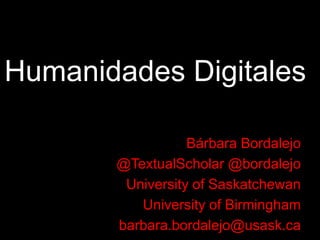
Codificación de textos medievales
- 1. Humanidades Digitales Bárbara Bordalejo @TextualScholar @bordalejo University of Saskatchewan University of Birmingham barbara.bordalejo@usask.ca
- 2. Las Humanidades Digitales (HD) son un área de investigación, creación y enseñanza que se ocupa de la intersección entre las disciplinas humanísticas y las tecnologías de computación. Abarca una amplia gama de temas, desde desarrollar una colección digital, libros electrónicos, archivos y museos digitales, hasta minería de datos de bases de datos culturales, visualización y herramientas digitales destinadas a la lingüística, literatura, historia, arqueología, antropología, entre otras, incorporando materiales digitalizados y nacidos digitales. Nuestra propuesta de qué es un humanista
- 3. Objetivos ¿Qué es la codificación de textos? ¿Cómo funciona? HTML, XML and XHTML Textual Encoding Initiative
- 4. ¿Qué son los lenguages de marcado? Se trata de una serie de instrucciones en un documento para componer un texto. De Wikipedia: son “sistemas para anotar documentos en formas que se pueden distinguir sintácticamente del texto.”
- 8. Tipos de codificación De presentación De procedimiento Descriptiva
- 11. Lenguajes de marcado SGML HTML XHTML XML Standard Generalized Markup Language HyperText Markup Language eXtensible HyperText Markup Language eXtensible Markup Language
- 12. HTML DOCTYPE Document Type Declaration <!DOCTYPE html PUBLIC "-//W3C//DTD XHTML 1.0 Transitional//EN" "http://www.w3.org/TR/xhtml1/DTD/xhtml1transitional.dtd"> <!DOCTYPE html> Element s Attribute s Empty elements Los elementos básicos que se usan en HTML Modificadores que alteran los elementos No tienen contenido
- 13. HTML Element s Los elementos básicos que se usan en HTML <h1>Título</h1> <p>Lo que sea que quieras decir sobre cualquier cosa que puedas pensar.</p> <p>Todavía más cosas que quieras decir sobre lo mismo.</p>
- 14. HTML Element s Los elementos básicos que se usan en HTML <h1>Título</h1> <p>Lo que sea que quieras decir sobre cualquier cosa que puedas pensar.</p> <p>Todavía más cosas que quieras decir sobre lo mismo.</p>
- 15. HTML Attribute Modificadores que alteran los s elementos Un hiperenlace se codifica <a> </a> Pero para completar el hiperenlace se requiere un atributo que defina la referencia: <a href=“http://www.w3schools.com/html/html_attribu tes.asp”> http://www.w3schools.com/html/html_attributes.as p </a>
- 16. HTML Attribute Modificadores que alteran los s elementos Un hiperenlace se codifica <a> </a> Pero para completar el hiperenlace se requiere un atributo que defina la referencia: <a href=“http://www.w3schools.com/html/html_attribu tes.asp”> http://www.w3schools.com/html/html_attributes.as p </a>
- 19. The Machine Us/ing Us http://www.youtube.com/watch?v=bBj7Tq M5rIE
- 20. XML TEI header simple TEI header complejo Descripción de códices Codificación de texto
- 21. <TEI> <teiHeader> <fileDesc> <titleStmt> <title> Título</title> </titleStmt> <publicationStmt> <p>Obra en preparación</p> </publicationStmt> <sourceDesc> <p>Fuente del texto.</p> </sourceDesc> </fileDesc> </teiHeader> <text> <body> <div type="chapter"> <head>Título</head> <p>El primer párrafo.</p> <p>El segundo párrafo. </p> </div> </body> </text> </TEI>
- 22. <TEI> <teiHeader> <fileDesc> <titleStmt> <title>Título</title> <principal>Nombre del investigador principal.</principal> </titleStmt> <publicationStmt> <publisher>Cambridge University Press</publisher> <date>1995</date> <availability status="restricted"><p>Prohibida su distribución.</p></availability> </publicationStmt> <sourceDesc> <bibl>Fuente del texto.</bibl> </sourceDesc> </fileDesc> <encodingDesc> <projectDesc> <p>Tu proyecto.</p> </projectDesc>
- 23. <editorialDecl> <correction status="low"> <p>Light</p> </correction> <normalization method="silent"> <p>Light</p> </normalization> </editorialDecl> </encodingDesc> <profileDesc> <langUsage> <language id="EN">English</language> </langUsage> </profileDesc> <revisionDesc> <change n="2"> <date>2/3/95</date> <respStmt> <name>You </name> <resp>Editor</resp> </respStmt> <item>Second check</item> </change>
- 24. <change n="1"> <date>1/3/95</date> <respStmt> <name>Me </name> <resp>Drudge</resp> </respStmt> <item>First check</item> </change> </revisionDesc> </teiHeader> <text> <body> <div type="chapter"> <head>The title</head> <p>The first paragraph</p> <p>The second paragraph</p> </div> </body> </text> </TEI>
- 25. <msDesc xml:id="CTPDHg" n="Hg"> <msIdentifier> <settlement><name type="place">Aberystwyth</name></settlement> <repository>National Library of Wales</repository> <idno> Peniarth 392 D </idno> <altIdentifier><idno>Hengwrt MS 154</idno></altIdentifier> </msIdentifier> <msContents> <p><title rend="ital">Canterbury Tales</title> (mutilated: missing <rs type="CTPD-F">VIII 554-1481</rs> [probably never included in Hg] and <rs type="CTPD-F">X 1180-end</rs>; <ref target="NIMEV"><hi rend="ital">NIMEV</hi></ref> 4019/45)</p> <note type="taleorder"> <p>Present order: <rs type="CTPD-F">I III VII<hi rend="sup">ef</hi> IX II V<hi rend="sup">a</hi> IV<hi rend="sup">b</hi> V<hi rend="sup">b</hi> VIII<hi rend="sup">a</hi> IV<hi rend="sup">a</hi> VI VII<hi rend="sup">abcd</hi> X (to 1180)</rs></p> <p>There are good reasons to believe that <rs type="CTPD-F">VII<hi rend="sup">ef</hi> IX</rs> (Section II) were intended to follow <rs type="CTPDF">II V<hi rend="sup">a</hi> IV<hi rend="sup">b</hi> V<hi rend="sup">b</hi> VIII<hi rend="sup">a</hi> IV<hi rend="sup">a</hi> VI VII<hi rend="sup">abcd</hi></rs> (Section IV): Section II begins with the <rs type="CTPD-T">Mel-Mk link</rs>, and Section V, in its first line (fol. <figure n="Hg235r"><figDesc>235<hi rend="sup">r</hi></figDesc></figure>), signals that the <rs
- 26. Descripción de códices http://www.sdeditions.com/AnaServer?CTPCAT+0+start .anv+ms=Hg#namelocation
- 28. <text> <body> <pb n="2r" facs="2R.JPG"/> <div n="GP" type="G"> <lb/><l n="IRE">Here bygynneth the Book of the tales of Caunt </am><ex>er</ex>bury.</l> <lb/><l n="1">WHan that Aueryll w<am>ᵗ</am><ex> ith</ex> his shoures soote</l> <lb/><l n="2">The droghte of March / hath <am>ꝑ</am><ex>per</ex>ced to the roote</l> <lb/><l n="3">And bathed euery veyne in swich lycour</l> <lb </am><ex>er</ex>tu engendred is the flour</l> <lb/><l n="5">Whan zephirus eek w<am>ᵗ</am><ex> ith</ex> his sweete breeth</l> <lb/><l n="6">Inspired hath in euery holt and heeth</l> <lb/><l n="7">The tendre croppes / and the yonge sonne</l> <lb/><l n="8">Hath in the Ram / his half cours yronne</l> <lb/><l n="9">And smale foweles / maken melodye</l> <lb/><l n="10">That slepen al the nyght with open Iye</l> <lb/><l n="11">So priketh hem nature / in hir corages</l> <lb/><l n="12">Thanne longen folk to goon on pilgrymages</l> <lb/><l n="13">And Palmeres for to seeken straunge strondes</l> <lb/><l n="14">To ferne halwes / kouthe in sondry londes</l> </body> </text> </TEI>
- 31. Límites y posibilidades Con la flexibilidad del TEI también vienen problemas de compatibilidad. Esa misma flexibilidad permite
- 32. Consideraciones teóricas Consideraciones para transcripciones 1. ¿Qué transcribir? 2. ¿Con qué finalidad? 3. ¿Cómo transcribir? 4. Grado de complejidad de la transcripción
- 37. Now if we could <app> <rdg type="orig">but get</rdg> <rdg type="c1">get</rdg> <rdg type="lit"> <seg type="rp”> <seg type="overwritten" rend="pencil" >but</seg> <seg type="overwrite" rend="ink" >get</seg> </seg > <seg type="strike" rend="ink" ><seg rend="pencil">get</seg></seg> </rdg> </app>
- 38. Now if we could <app> <rdg type="orig">but get</rdg> <rdg type="c1">get</rdg> <rdg type="lit"> <seg type="rp”> <seg type="overwritten" rend="pencil" >but</seg> <seg type="overwrite" rend="ink" >get</seg> </seg > <seg type="strike" rend="ink" ><seg rend="pencil">get</seg></seg> </rdg> </app>
- 39. Now if we could <app> <rdg type="orig">but get</rdg> <rdg type="c1">get</rdg> <rdg type="lit"> <seg type="rp”> <seg type="overwritten" rend="pencil" >but</seg> <seg type="overwrite" rend="ink" >get</seg> </seg > <seg type="strike" rend="ink" ><seg rend="pencil">get</seg></seg> </rdg> </app>
